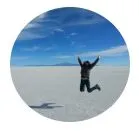
Have you got Travel Insurance?
- Unfortunately, things can and do go wrong when you travel. I never leave home without travel insurance, so consider getting insurance for your trip to cover things like adventure sports and activities as well as emergency medical, lost luggage, stolen items, trip cancellation and more.
- Get a quote for your trip from True Traveller if you're based in the UK, or World Nomads or SafetyWing which both offer travel insurance for backpackers and long-term travellers. Alternatively, use a comparison site like Travel Insurance Master to find the best cover for you.








Nice overview of Bolivia, lots of good tips there. Will be reading lots more of your stuff for my next trip, which is Mexico, Belize and Guatemala. Thank you for all the goodness you offer.
For my South America holiday, Peru was the main focus, but upon leaving Bolivia, I wished I had longer there.
I too loved Bolivia. I went to the Amazon through Rurrenbaque as you mentioned, blew my mind to think I was walking through the town which is the gateway to the Amazon. As for staying by the river, and seeing caiman, macaws, howler monkeys and more on a daily basis, those memories will stay with me a long, long time.
The cable cars in La Paz give a simply stunning view as to the hugely expansive layout of the city, how the houses have been built up the sides of the mountains. It just goes on and on and on.
Salar de Uyuni, are there any words to say how beautiful that place is?